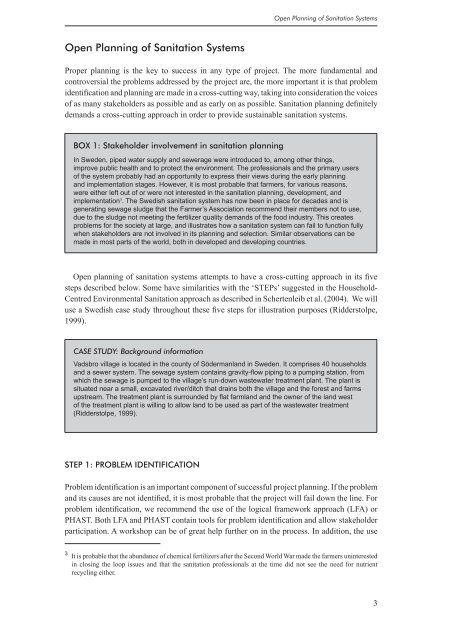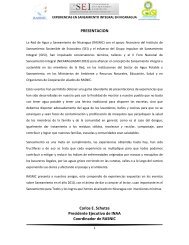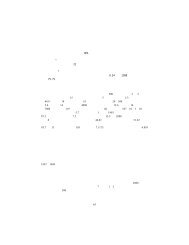Open Planning of Sanitation Systems
Open Planning of Sanitation Systems
Open Planning of Sanitation Systems
You also want an ePaper? Increase the reach of your titles
YUMPU automatically turns print PDFs into web optimized ePapers that Google loves.
<strong>Open</strong> <strong>Planning</strong> <strong>of</strong> <strong>Sanitation</strong> <strong>Systems</strong><strong>Open</strong> <strong>Planning</strong> <strong>of</strong> <strong>Sanitation</strong> <strong>Systems</strong>Proper planning is the key to success in any type <strong>of</strong> project. The more fundamental andcontroversial the problems addressed by the project are, the more important it is that problemidentification and planning are made in a cross-cutting way, taking into consideration the voices<strong>of</strong> as many stakeholders as possible and as early on as possible. <strong>Sanitation</strong> planning definitelydemands a cross-cutting approach in order to provide sustainable sanitation systems.BOX 1: Stakeholder involvement in sanitation planningIn Sweden, piped water supply and sewerage were introduced to, among other things,improve public health and to protect the environment. The pr<strong>of</strong>essionals and the primary users<strong>of</strong> the system probably had an opportunity to express their views during the early planningand implementation stages. However, it is most probable that farmers, for various reasons,were either left out <strong>of</strong> or were not interested in the sanitation planning, development, andimplementation 3 . The Swedish sanitation system has now been in place for decades and isgenerating sewage sludge that the Farmer’s Association recommend their members not to use,due to the sludge not meeting the fertilizer quality demands <strong>of</strong> the food industry. This createsproblems for the society at large, and illustrates how a sanitation system can fail to function fullywhen stakeholders are not involved in its planning and selection. Similar observations can bemade in most parts <strong>of</strong> the world, both in developed and developing countries.<strong>Open</strong> planning <strong>of</strong> sanitation systems attempts to have a cross-cutting approach in its fivesteps described below. Some have similarities with the ‘STEPs’ suggested in the Household-Centred Environmental <strong>Sanitation</strong> approach as described in Schertenleib et al. (2004). We willuse a Swedish case study throughout these five steps for illustration purposes (Ridderstolpe,1999).CASE STUDY: Background informationVadsbro village is located in the county <strong>of</strong> Södermanland in Sweden. It comprises 40 householdsand a sewer system. The sewage system contains gravity-flow piping to a pumping station, fromwhich the sewage is pumped to the village’s run-down wastewater treatment plant. The plant issituated near a small, excavated river/ditch that drains both the village and the forest and farmsupstream. The treatment plant is surrounded by flat farmland and the owner <strong>of</strong> the land west<strong>of</strong> the treatment plant is willing to allow land to be used as part <strong>of</strong> the wastewater treatment(Ridderstolpe, 1999).STEP 1: PROBLEM IDENTIFICATIONProblem identification is an important component <strong>of</strong> successful project planning. If the problemand its causes are not identified, it is most probable that the project will fail down the line. Forproblem identification, we recommend the use <strong>of</strong> the logical framework approach (LFA) orPHAST. Both LFA and PHAST contain tools for problem identification and allow stakeholderparticipation. A workshop can be <strong>of</strong> great help further on in the process. In addition, the use3 It is probable that the abundance <strong>of</strong> chemical fertilizers after the Second World War made the farmers uninterestedin closing the loop issues and that the sanitation pr<strong>of</strong>essionals at the time did not see the need for nutrientrecycling either.3



![Project Document [PDF: 2.31 MB] - EcoSanRes](https://img.yumpu.com/51279385/1/184x260/project-document-pdf-231-mb-ecosanres.jpg?quality=85)












![Latrines à compost [high-resolution colour PDF: 12.3MB] - EcoSanRes](https://img.yumpu.com/31726141/1/185x260/latrines-a-compost-high-resolution-colour-pdf-123mb-ecosanres.jpg?quality=85)